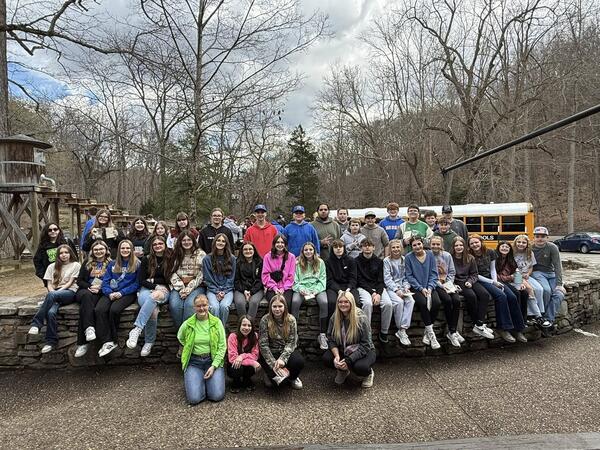You have /5 articles left.
Sign up for a free account or log in.

TRIO programs have long been touted as a bridge to and through college. Now they’re at risk.
Justin Morrison/Inside Higher Ed | ferrantraite/E+/Getty Images | Morehead State University
Darby Bersie will graduate with honors this Friday from Bemidji State University, a small regional college in central Minnesota. At commencement, he’ll deliver a speech as president of the university’s Student Senate. He’s set to defend his thesis, a research project on intellectual diversity in higher education, shortly after. Graduate school may be on the horizon.
Just a few years ago, Bersie wasn’t even sure he’d be able to finish a four-year degree. Neither of his parents had gone to college. He’d grown up poor, moving around the Upper Midwest after his family declared bankruptcy in 2015. He spent his high school years working part-time on the farm his family rented in central Minnesota.
He credits his success at Bemidji to TRIO, a federally funded initiative dating back to the 1960s that supports low-income, first-generation college students and students with disabilities as they navigate academic life—and that currently faces an existential threat from the Trump administration.
In a preliminary budget released last week, the White House proposed billions of dollars in cuts to education funding, including eliminating all federal support for TRIO programs. Administration officials called TRIO a “relic of the past” and argued that federal subsidies had relieved colleges of the responsibility to attract and support low-income students on their own.
“Today, the pendulum has swung and access to college is not the obstacle it was for students of limited means,” officials wrote in the proposal. “A renewed focus on academics and scholastic accomplishment by [institutions], rather than engaging in woke ideology with federal taxpayer subsidies, would be a welcome change.”
Bersie couldn’t disagree more.
“I can say with 100 percent confidence that without TRIO, I wouldn’t be graduating this Friday, let alone standing on the stage addressing my peers,” Bersie said. “It’s scary to think I could be the last generation to get this opportunity.”
TRIO is made up of eight different programs. They include the McNair Scholars Program; Talent Search, which educates middle and high school students about the college admissions and financial aid processes; Educational Opportunity Centers, which support adult learners; Student Support Services, which focus on college persistence; and three different Upward Bound programs, with one focused on STEM and another on veterans.
You could criticize a lot of federal education programs for very obvious gaps. TRIO ain’t one of them.”
—Barmak Nassirian, Veterans Education Success
Federal law requires that all TRIO beneficiaries be first-generation college students and that two-thirds have a household income of no more than 150 percent of federal poverty levels. More than 3,500 TRIO programs at 1,000 colleges and community-based organizations currently serve nearly 875,000 low-income students, 50,000 rural students, 7,000 students with disabilities and 6,000 veterans.
TRIO’s $1.2 billion in federal grants also funds many underresourced universities’ student support services. These institutions—community colleges, rural regional public universities and small private colleges—have the most to lose if TRIO is eliminated; for some, there would be no student success offices or academic advising without it.
‘The Only Bridge’
Dallas Doane, associate professor of higher education administration at the University of Kansas, used to lead the TRIO-funded Student Support Services office at the University of South Dakota. He said he’s seen firsthand how the programs can open students’ eyes to new possibilities.
“In many rural and underserved areas, where maybe there isn’t a four-year college for hundreds of miles, TRIO is the only bridge to higher education,” Doane said. “TRIO transforms lives.”
Chris Solario, director of student support services at Western Oregon University, administers two TRIO-funded programs serving 400 students, or about 12 percent of the student body. He said that years back, a widower and single father of three who’d never earned his bachelor’s degree returned to school with the support of Western Oregon’s TRIO programs. He excelled in the classroom and went on to attend law school.
“I don’t think he would’ve made it there without us,” he said. Solario himself is a TRIO alum, having gone back to school 18 years after leaving high school; he’s not sure he would’ve made it on his own, either.
Research shows that TRIO programs can boost low-income college-going and persistence rates. Talent Search participants are 33 percent more likely than their peers in the bottom income quartile nationwide to enroll in college, according to the Council for Opportunity in Education; Upward Bound students are twice as likely as their peers to earn a bachelor’s degree, and McNair scholars are 78 percent more likely to enroll in a graduate program.
We do not peddle in any woke ideologies. We are here simply to promote low-income, first-generation, students with disabilities’ access to college.”
—Summer Bryant, vice president of KY TRIO
Students in TRIO precollege programs are “besting their peers in terms of matriculating to college,” and college students in TRIO programs “outpace their peers” in retention and attainment, said Kimberly Jones, president of the Council for Opportunity in Education.
“TRIO is the insurance policy for financial aid,” she added. “If you give a student a Pell Grant, but then you don’t give them the resources to complete their degree … it’s sort of like giving a 16-year-old a pair of car keys, but you didn’t teach them how to drive.”
The programs are an important resource for veterans, too, said Barmak Nassirian, vice president for higher education policy at Veterans Education Success. He said veterans come to college with the same challenges as other adult learners, like jobs and childcare responsibilities, on top of the added struggles of adjusting back to civilian life. The Veterans Upward Bound program operates with those unique circumstances in mind.
He argued TRIO programs are “relatively inexpensive” compared to federal spending on financial aid, student loans or GI Bill benefits, and that cutting them would mean “denying people that little bit of additional support that could make those billions of dollars translate into meaningful credentials.”
“You could criticize a lot of federal education programs for very obvious gaps,” Nassirian said. “TRIO ain’t one of them.”
Adam Kissel, a visiting fellow at the Heritage Foundation’s Center for Education Policy, used to help run TRIO as deputy assistant secretary for higher education programs during the first Trump administration. He said that federal money is opening too many doors to four-year degrees and postgraduate education. There’s an “overenrollment problem,” he said; too many students are attending college without being prepared to graduate.
“Over the past few decades, we have dramatically expanded access [to higher education] at great humanitarian expense, because graduation rates are abysmal,” he said. “For those who don’t graduate, income is a huge factor … Maybe we’re making their lives worse by encouraging them [to pursue four-year and postgraduate degrees].”
Kissel argued that there’s no reliable evidence proving TRIO helps low-income students succeed. In 2009, the Education Department commissioned a report that compared participants in TRIO—then just known as Upward Bound—to a random selection of peers and found little difference in enrollment or persistence outcomes. States and institutions, he argued, are better positioned to dole out resources and measure their efficacy. (A 2014 report by the Pell Institute pushed back on these findings.)
But Doane said TRIO programs have built-in accountability: To apply for grants, universities must set specific benchmarks for each project, and they risk losing funding if they don’t achieve their goals.
“These benchmarks represent some of the most rigorous evaluation and assessment requirements of any student success grant,” Doane said.
Can Colleges Triage a TRIO Cut?
TRIO advocates worry that less well-resourced institutions could lose critical student support services if federal funding is eliminated.
“The vast majority of [institutions with TRIO programs] are community colleges, they are regional institutions, they are HBCUs,” Jones said. “They are not institutions that have additional resources, whereas TRIO brings millions of dollars to their campuses to help boost what they’re already doing.”
Solario said that if TRIO funding were cut right now, Western Oregon would not be able to sustain his office. Last year 88 percent of his students graduated with a degree, twice the rate of first-generation, low-income students nationwide.
At Clatsop Community College, Christine Riehl, director of the TRIO Student Support Services Project, said “there is no way” the small, rural institution in northwest Oregon could foot the bill for all the services TRIO provides, and neither could the state.
She said her team provides the lion’s share of academic and career advising at the college and all formal career-exploration opportunities. They also dole out scholarships, connect students to social services and run trips to the nearest university, which is two hours away, to help students consider transferring after obtaining their associate degree.
Eliminating TRIO programs would be particularly devastating for rural communities, said Summer Bryant, director of TRIO Talent Search Programs at Morehead State University in eastern Kentucky and vice president of KY TRIO.

Morehead State University sponsors a Talent Search program for local middle school students.
Morehead State University
Rural students already face barriers to getting to and through college, like limited transportation and broadband access, Bryant said. Kentucky TRIO programs support about 20,000 students across 96 counties in the state, including some areas with the highest food insecurity rates in the country.
“It’s not enough to hand students a few thousand dollars for college from the federal Pell Grant and send them on their merry way,” Bryant said. “You have to put the support systems in place for those students to be successful.”
She emphasized that TRIO programs over all receive bipartisan support, with Republicans and Democrats participating in the Congressional TRIO Caucus.
“We do not peddle in any woke ideologies,” she said. “We are here simply to promote low-income, first-generation, students with disabilities’ access to college,” whether that’s a welding certificate or a Ph.D.
She and other members of her team have been making calls to lawmakers to advocate for the programs, alongside TRIO students, alumni and parents. She hopes those efforts pay off.
Kissel said he anticipates they will and that the White House will struggle to get its proposed TRIO cuts through Congress.
“I’d give it about a 1 percent chance,” he said. “There’s a very strong lobby for TRIO.”
In February, Bersie traveled with a group of other Minnesota students to Washington, D.C. They met with Minnesota senators and representatives—or at least their senior staff—and advocated for federal programs like TRIO. Bersie spoke with Republican staffers about the role TRIO played in his confidence and success at Bemidji. He said they were hesitant to lend their full support to the programs—many questioned whether it wouldn’t make more sense for the states to handle that kind of funding—but he left feeling like he’d been heard.
He hopes they remember his story when the time comes to decide TRIO’s fate.






